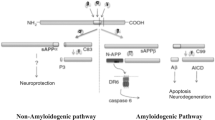Abstract
Strong evidence links excess production of a small peptide and the pathogenesis of Alzheimer’s disease (AD). Originally this peptide, beta-amyloid 42 (Aβ42), was assumed to be released by a pathogenic event; it is now well established that Aβ42 is released from cells during normal cellular metabolism of the Alzheimer amyloid precursor protein. Recently, in a series of surprising reports it was discovered that Aβ42 is produced intracellularly, and what might have been regarded first as a strange abnormality of a few selected cell lines has now been recognized as an important cellular pathway for Aβ production. Moreover, the differences between secretory and intracellular Aβ production might hold the clues for brain specificity and cellular mechanisms of AD pathogenesis.
Similar content being viewed by others
Author information
Authors and Affiliations
Rights and permissions
About this article
Cite this article
Hartmann, T. Intracellular biology of Alzheimer’s disease amyloid beta peptide. European Archives of Psychiatry and Clinical Neurosciences 249, 291–298 (1999). https://doi.org/10.1007/s004060050102
Issue Date:
DOI: https://doi.org/10.1007/s004060050102




